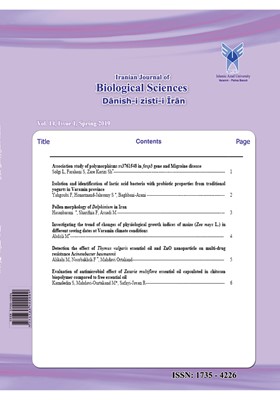-
-
List of Articles
-
Open Access Article
1 - Association study of polymorphisms rs3761548 in FOXP3 gene and Migraine disease
Leila Solgi Sedigheh Farahani شهره زارع کاریزی -
Open Access Article
2 - isolation and identification of lactic acid bacteria with probiotic potential from traditional yogurt in Varamin province.
سحر هنرمند جهرمی fahimeh baghbani-arani Fatemeh Yaghoubi -
Open Access Article
3 - Pollen morphology of Delphinium in Iran
Masoomeh Hasanbarani fariba Sharifnia Mostafa Assadi -
Open Access Article
4 - Investigating the trend of changes of physiological growth indices of maize (Zea mays L.) in different sowing dates at Varamin climate conditions
Majid Abdoli -
Open Access Article
5 - Detection the effect of Thymus vulgaris essential oils and Zno nanoparticle on multi drug resistance acinetobacter baumannii
Fatemeh Noorbakhsh Mozhgan Alikahi Maasuomeh Mahdavi Ourtakand -
Open Access Article
6 - Evaluation of antimicrobial effect of Zataria multiflora essential oil capsulated in chitosan biopolymer compared to free essential oil
Maasuomeh Mahdavi Ourtakand
-
The rights to this website are owned by the Raimag Press Management System.
Copyright © 2021-2025







